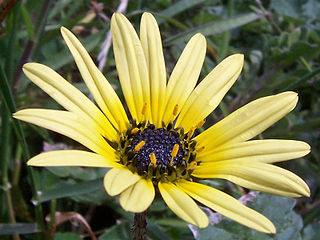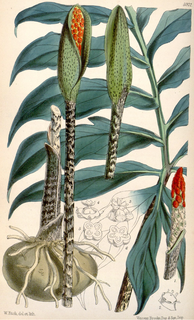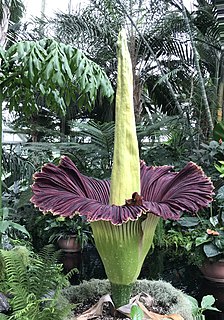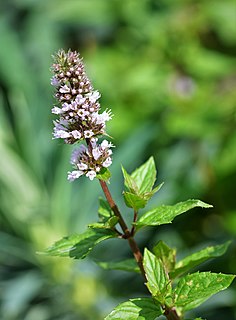
Royal Botanic Gardens, Kew, is a non-departmental public body in the United Kingdom sponsored by the Department for Environment, Food and Rural Affairs. An internationally important botanical research and education institution, it employs 1,100 staff. Its board of trustees is chaired by Dame Amelia Fawcett.

Goldenrod is a common name for many species of flowering plants in the sunflower family, Asteraceae, commonly in reference to the genus Solidago.

Cathaya is a genus in the pine family, Pinaceae, with one known living species, Cathaya argyrophylla. Cathaya is a member of the subfamily Laricoideae, most closely related to Pseudotsuga and Larix. A second species, C. nanchuanensis, is now treated as a synonym, as it does not differ from C. argyrophylla in any characters.

Hepatica is a genus of herbaceous perennials in the buttercup family, native to central and northern Europe, Asia and eastern North America. Some botanists include Hepatica within a wider interpretation of Anemone.

Selenicereus, sometimes known as moonlight cactus, is a genus of epiphytic, lithophytic, and terrestrial cacti, found in Mexico, Central America, the Caribbean and northern South America. The term night-blooming cereus is also sometimes used, but this is also used for many night-blooming cacti, including Epiphyllum and Peniocereus. In 2017, the genus Hylocereus was brought into synonymy with Selenicereus. A number of species of Selenicereus produce fruit that is eaten. The fruit, known as pitaya or pitahaya in Spanish or as dragon fruit, may be collected from the wild or the plants may be cultivated.

Wakehurst, previously known as Wakehurst Place, is a house and botanic gardens in West Sussex, England, owned by the National Trust but used and managed by the Royal Botanic Gardens, Kew. It is near Ardingly, West Sussex in the High Weald, and comprises a late 16th-century mansion and a mainly 20th-century garden, and Kew's Millennium Seed Bank, in a modern building. Visitors are able to see the gardens, the Mansion, and also visit the seed bank. The garden today covers some 2 km2 and includes walled and water gardens, woodland and wetland conservation areas.

Arctotheca is a small genus of flowering plants in the aster family. They are annuals or perennials native to southern Africa.

Asterostigma is a genus of flowering plants in the family Araceae. It is native to Brazil and Argentina. The leaves are pinnate and the plant is tuberous.
- Asterostigma cryptostylumBogner - Brasília, Goiás, Minas Gerais
- Asterostigma cubense(A.Rich.) K.Krause ex Bogner - São Paulo
- Asterostigma lividum(G.Lodd.) Engl. - southern Brazil; Misiones Province of Argentina
- Asterostigma lombardiiE.G.Gonç. - Minas Gerais, Espírito Santo
- Asterostigma luschnathianumSchott - southern Brazil
- Asterostigma reticulatumE.G.Gonç - southern Brazil
- Asterostigma riedelianum(Schott) Kuntze - eastern Brazil
- Asterostigma tweedieanumSchott - Santa Catarina in southern Brazil

Amorphophallus titanum, the titan arum, is a flowering plant with the largest unbranched inflorescence in the world. The talipot palm, Corypha umbraculifera, has a larger inflorescence, but it is branched rather than unbranched. Amorphophallus titanum is endemic to Sumatra.

Kew Gardens is a botanic garden in southwest London that houses the "largest and most diverse botanical and mycological collections in the world". Founded in 1840, from the exotic garden at Kew Park in Middlesex, England, its living collections includes some of the 27,000 taxa curated by Royal Botanic Gardens, Kew, while the herbarium, which is one of the largest in the world, has over 8.5 million preserved plant and fungal specimens. The library contains more than 750,000 volumes, and the illustrations collection contains more than 175,000 prints and drawings of plants. It is one of London's top tourist attractions and is a World Heritage Site.

Lumnitzera is an Indo-West Pacific mangrove genus in the family Combretaceae. An English common name is black mangrove. Lumnitzera, named after the German botanist, Stephan Lumnitzer (1750-1806), occurs in mangroves from East Africa to the Western Pacific, and northern Australia.

Euphorbia hirta is a pantropical weed, originating from the tropical regions of the Americas. It is a hairy herb that grows in open grasslands, roadsides and pathways in the warmer regions of India and Australia as an introduced species. It is used in traditional herbal medicine.
The Plant List is a list of botanical names of species of plants created by the Royal Botanic Gardens, Kew and the Missouri Botanical Garden and launched in 2010. It was intended to be a comprehensive record of all known names of plant species over time, and was produced in response to Target 1 of the 2002-2010 Global Strategy for Plant Conservation, to produce "An online flora of all known plants.” It has not been updated since 2013, and is superseded by World Flora Online.
The World Checklist of Selected Plant Families is an "international collaborative programme that provides the latest peer reviewed and published opinions on the accepted scientific names and synonyms of selected plant families." Maintained by the Royal Botanic Gardens, Kew, it is available online, allowing searches for the names of families, genera and species, as well as the ability to create checklists.
GrassBase is a web-based database of grasses, continually maintained and updated by the Royal Botanic Gardens, Kew.
Plants of the World Online is an online database published by the Royal Botanic Gardens, Kew. It was launched in March 2017 with the ultimate aim being "to enable users to access information on all the world's known seed-bearing plants by 2020". The initial focus was on tropical African Floras, particularly Flora Zambesiaca, Flora of West Tropical Africa and Flora of Tropical East Africa.

Nepetoideae is a subfamily of plants in the family Lamiaceae.

Hypericum przewalskii, commonly called Przewalski's St. John's wort, is a flowering plant in Hypericumsect. Roscyna that is native to China.

World Flora Online is an Internet-based compendium of the world’s plant species.

Protea namaquana, also known as the Kamiesberg sugarbush, is a flowering plant which belongs to the genus Protea. The plant is endemic to the southwestern Cape Region of South Africa, in particular the Kamiesberg mountains of Namaqualand in the Northern Cape province. The species has a worldwide distribution of only 18 km2. It is regarded as critically endangered. In the Afrikaans language it has the vernacular name is Kamiesbergsuikerbos.















